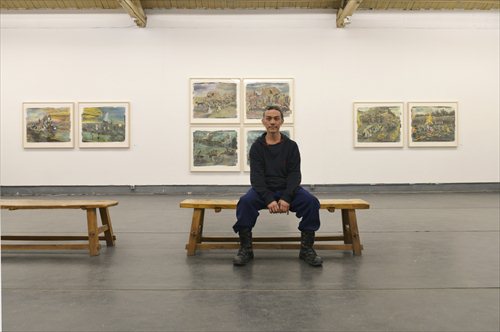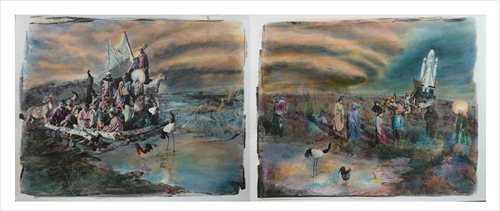History as a mirror
Photographic artist remixes human stories on his hand-painted films
About half of the country uses smartphones now. With the small digital device, taking photos and processing them with editing apps have never been more convenient.
Yet what we achieve in the easiest way is usually not what we will value. That is, compared with what we photograph, the action of shooting is possibly more important.
But many artists working in photography put in much more effort in their process, with an aim to producing works layered with detail and meaning. Chinese photographer Chen Nong spent three years on his latest work, a set of 16 pictures.
His long process in creating Silk Road is rewarded with surprising photographs with a texture of painting and in the style of mystical realism.
There is a pool of information, of different layers and dimensions, in his photos, arresting people to examine detail by detail as if to unveil a secret in history.
Silk Road is composed of eight pairs of different scenes.
The artist visited the vast areas in West China to learn the region's history, poring over books and cultural relics; afterward, he sketched drafts of images he wanted to shoot, then created props and costumes.
He then went back to West China and found models; he shot on black-and-white film and hand-colored the prints with sensitive emulsions in the darkroom.
"Chen Nong's work is permeated with a breath of absurdity. Irrelative elements are forcibly drawn together by him, which seems inharmonious yet somehow shows a solemn power and a desire to get away," Chinese artist Wang Chong once commented on Chen Nong's artworks.

Chinese photographer Chen Nong
A play in a play
Recently, this series and a portion of another, The 16 Scenes of Seclusion, created in the past year, have been on display at A Play in a Play: Chen Nong Photography Exhibition.
"I want to capture the life in West China," Chen said when asked by the Global Times what inspired him to start Silk Road.
Before this series, he had done Yellow River, Three Gorges and Ancient Town, traversing different parts of the country and winning him critical acclaim in the global art scene.
Among his collectors is the San Francisco Museum of Modern Art, New York's International Center for Photography and the Art Museum of Harvard University.
"The landscape and culture there are very different, and more important, from past to now, some places have been well-preserved, so it's easier for people to see the history there."
He went to Qitai, Tulufan and the site of Gaochang in Xinjiang Uyghur Autonomous Region; paid a visit to Qinghai and Gansu provinces; and spent about half a year at Dunhuang Grottoes to copy pictures from murals, which depict both significant historical events and everyday life of the ancient people.
And at the end of the second year, he finished sketches for 16 pictures for Silk Road and spent the last year shooting and processing these photos. All in all, he said, the project cost him roughly 400,000 yuan ($61,585).
According to Chen, the series follows a story about life. It starts with two pictures depicting the civilization's doomsday, and then flashes back to pictures of wars and natural disasters that happened there.
Also reviewed are the daily lives of the people and historic events, including a Han official being dispatched to Northwest China and a Han princess marrying a Tibetan leader, before Chen concludes the story with a memorial ceremony corresponding to its opening scene.
"I'm interested in any period of history, but I don't like them at all. Because I think every period of history is bloody, and human history is a shame because of all the killing," Chen said.
"Human society has been like a bloody jungle so far. There are improvements that lead people out of the jungle, but looking back, it's still a cruel story."
There is a saying that history serves as a mirror so that we can avoid past tragedies.
For Chen, his photographs are also mirrors, in which people can see reflections of their own selves and possibly discover their unknown aspects.

Silk Road · Lastday on display Photos: Courtesy of OFOTO Gallery
Free-minded auteur
To some extent, Chen resembles a film director as he makes up things that appear as virtual truths on his photos. He also shares something in common with his favorite film director, Tsai Ming-liang from Taiwan.
They both show great compassion and interest in humanity through their works, and the fact that each of Chen's pictures alone can attract viewers to examine and gaze echoes with Tsai's signature use of static, long takes, which often span at least a full minute.
Chen Haiyan, academic director of the exhibition, told the Global Times that she values Chen Nong not only for his artistic achievements, but also for his resolve to do what he loves and not capitulate to the whims of the art market.
"I must follow my heart; that's a priority for art," said Chen Nong. "If you don't do what you like, why bother doing art?"
The 16 Scenes of Seclusion on view at the exhibition has marked a turning point.
Compared with Silk Road and his earlier works, it doesn't highlight social background, and has only one or two models in each picture, accentuating their inner feelings through a vibe created in a natural environment.
The artist said that in the future he plans to do projects about introspection and people's innermost feelings.
Date: Until April 29, 10 am to 6 pm
Venue: OFOTO Gallery 全摄影画廊
Address: 2/F, Bldg 13, 50 Moganshan Road 莫干山路50号13幢2楼
Admission: Free
Call 6298-5426 for details